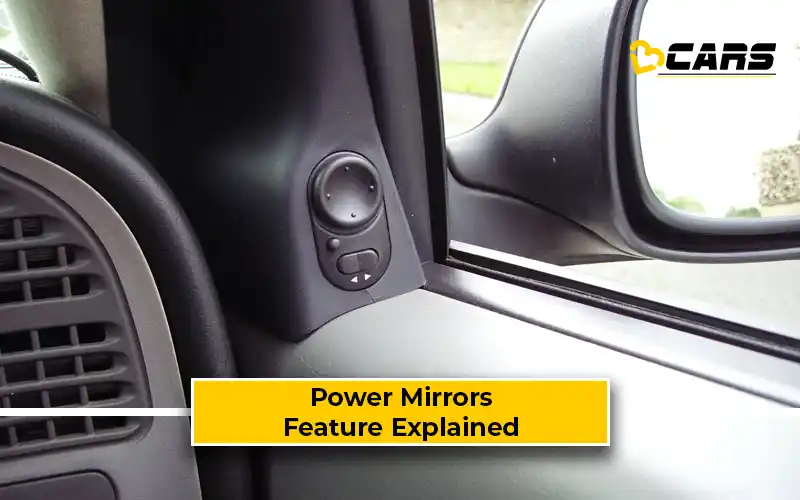Powered ORVMs Or Power Mirrors – Feature Explained
Gone are the days of manually reaching out to adjust your car’s side mirrors. Power mirrors, also known as Powered Outside Rear View Mirrors (ORVMs), are a standard feature in most modern cars and SUVs, offering a convenient and safe way to adjust your view without any physical strain.

What Are Power Mirrors (Powered ORVMs)?
Power mirrors are exterior rearview mirrors that can be adjusted electronically from inside the car, typically using a joystick-like control or buttons located on the driver’s door panel. This allows the driver to precisely set the mirror angles for optimal rearward visibility without needing to open the window or manually push the mirror glass.
How Does A Power Mirror Work?
The operation of power mirrors is surprisingly simple, relying on small electric motors:
- Control Input: When you move the joystick or press the directional buttons on the control panel (usually on the driver’s door), you send electrical signals to the mirror assembly.
- Motor Movement: Inside the mirror housing, small electric motors receive these signals. There are usually 2 motors – one for horizontal (left-right) adjustment and one for vertical (up-down) adjustment.
- Mirror Angle Adjustment: These motors precisely move the mirror glass to the desired angle.
- Integrated Functions (Optional): Many power mirror systems also include other convenient features:
- Power Folding: Motors fold the ORVMs inwards, useful for navigating narrow spaces or parking.
- Auto-Tilt in Reverse: The mirror automatically tilts downwards when reverse gear is engaged, providing a better view of curbs and obstacles.
- Memory Function: In higher-end cars, mirrors can remember preferred positions for different drivers.
What Are The Pros And Cons Of Power Mirrors?
Here are the pros, or advantages, of power mirrors:
- Convenience: Adjusting mirrors is quick and effortless from inside the cabin, even while driving.
- Enhanced Safety: Allows for quick, precise adjustments to eliminate blind spots on the go, improving overall situational awareness.
- Accessibility: Especially beneficial for drivers with limited mobility or when parking in tight spaces.
- Weather Protection: No need to open windows in bad weather (rain, cold) to adjust mirrors.
- Integrated Features: Often come with power-folding, auto-tilt, and memory functions, adding further convenience.
Here are the cons, or disadvantages, of power mirrors:
- Electronic Reliance: Being an electronic system, they can be prone to electrical malfunctions, motor failures, or switch issues, though this is rare in modern cars.
- Repair Cost: Repairing or replacing a faulty power mirror assembly can be more expensive than a simple manual mirror.
- Manual Override Not Always Possible: In case of an electrical fault, manual adjustment might not be possible without professional intervention.
Can Power Mirrors Be Installed From The Aftermarket?
Yes, power mirrors can be installed from the aftermarket, especially for cars that come with manual mirrors in lower variants but have power mirrors in higher trims. Aftermarket kits usually involve:
- Replacing the manual mirror assembly with a powered one.
- Installing new wiring.
- Adding the control switch/joystick on the door panel.
The complexity can vary from moderate to high, depending on the car model and whether the car’s wiring harness is “pre-wired” for power mirrors. Professional installation is highly recommended to ensure correct wiring and functionality.
Affordable Cars in India That Offer Power Mirrors?
Power mirrors are now a very common feature across most segments in India, even in many entry-level cars. They are usually standard from mid-variants upwards. Here are a few examples:
- Maruti Suzuki Alto K10
- Renault Kwid
- Tata Tiago
- Tata Tigor
- Hyundai Grand i10 Nios
- Maruti Suzuki Swift
Virtually any compact SUV, sedan, or premium hatchback sold in India today offers power mirrors as a standard or optional feature.
Also Read: 6 SUV Alternatives To The Tata Nexon In 2025
Helpful Tools:
- Fuel Cost Calculator for Cars – Know your monthly fuel expense based on usage and mileage
- Car On-Road Price Calculator – Convert ex-showroom to on-road price for any city
Sell Used Car Online – Enter your car and contact details to get an instant price estimate and book a free inspection with our partner network


The first disadvantage of a power side-view mirror may be a huge issue if they fail (screw-drive. Manually adjusting them makes that “crunch” sound, and wears out the mechanism) or a much more minor inconvenience (friction-drive). In the case of the latter, they can be adjusted by hand from the outside, but nowhere near as easily as a manual mirror. Another thing to note is with cars that come from the factory with power mirrors, the controls are sometimes connected to the battery (allowing you to adjust them while parked with the engine and electricals off), but sometimes they are switched by the ignition. This isn’t as big of an issue with keys as you can just turn the key to the “on” position if you don’t want to waste as much gas. With pushbutton start, it’s more annoying, as you need to push the button twice with your foot off the clutch (manual) or brake (automatic, maybe some manuals?), or do it with the engine idling
I have power mirrors with chrome back on my roush 2000 f150 ford pickup. I broke one mirror need to purchase new ones. What power mirrors do u recommend